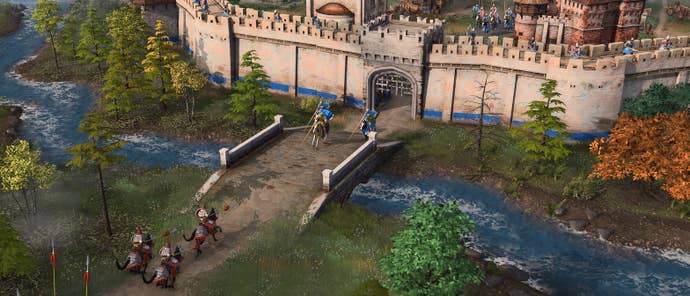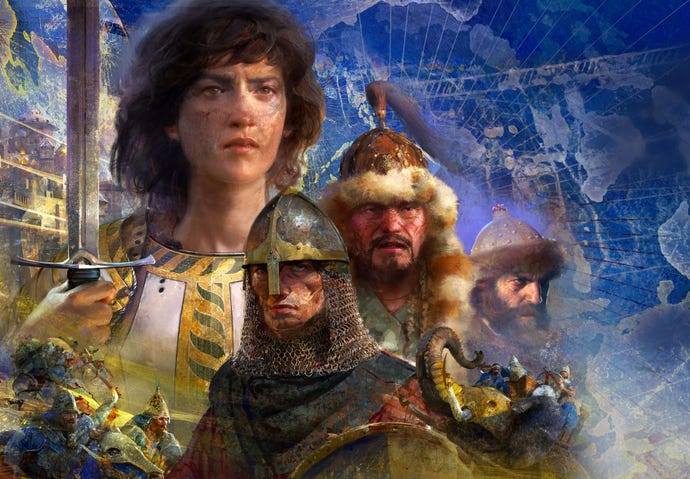Age of Empires 4 review — A learning experience
A safe, but absorbing real-time strategy game that respects its history.
Fires rage around you as lives crumble in the wake of your army’s unrelenting assault. Your foe surrenders at last. There’s rejoicing among the soldiers, but you pause and wonder why. Does raiding a small village and defeating a few peasants count as a victory worthy of pride? Age of Empires 4 is a video game before anything else, so regardless of how you feel about the events you control, this triumph ticks an objective box and earns experience.
It’s also a new kind of real-time strategy game, one that treats its history with more care and is intent on immersing you in it. World's Edge’s take on the classic real-time strategy series might seem overly familiar to devoted fans, and some of its ambition won’t be fully realized until after launch. What’s here, however, is Age of Empires at its finest.
Age of Empires 4 has eight civilizations to start with, and while the number might seem limited compared to AoE 2’s initial 13 empires, there’s a significantly improved balance in what regions are represented at launch. The lineup includes the Abbasids, the Delhi Sultanate, the Mongols, and the French, though you start with the English — or more accurately, the Normans. Age of Empires 4 puts you through the Battle of Hastings and other familiar fights once again, but with a few important differences.
Age of Empires 2 and 3 feature a historical battles mode that loosely reenacts important conflicts from the past, though “loosely” is key here. The Norman invasion of 1066 centers around destroying Harold’s castle in the second game, a gimmick that would have any history buff crying out in pain. Age of Empires 4 adheres more closely to the Bayeux Tapestry, battlefield landscape, and other chronicles it draws on for context. For example, it uses William’s decoy against the famed Saxon shield wall as a tutorial on unit management and only ends once Harold is slain on the noticeably castle-less battlefield.
.jpg?width=690&quality=70&format=jpg&auto=webp)
Age 4 moves beyond the focus on one great leader per civilization and opts for a more coherent overview of each period. The Norman era alone spans almost two centuries after the Battle of Hastings in the game, covering William’s brutal suppression of the northern rebels and the civil war that broke out among his children, before ending a little before the Hundred Years War, where the next campaign picks up.
World's Edge cushions each chapter with a brief, detailed overview of events that influenced the upcoming fight and that resulted from it. Rather than bludgeoning you with text, facts, and dates, it presents a higher-level overview of key details and people in smooth, documentary-like segments. These are consistently high points in each campaign, blending shots of the real-world locations with renders from the game and superimposing animated armies over the actual battlefields.
These, combined with the greater attention to historical detail in battles, illustrates World's Edge’s commitment to making Age of Empires 4 more than just another medieval combat simulator. Civilization is about being goofy, plunging the world into chaos or having a long-dead ruler lead their people into space. Old AoE is a race to conquer everyone else. Age of Empires 4 is still about subjugating your foes, but now with a greater understanding of why it happened and who it affected.
There’s plenty of the usual things you expect from AoE, though, such as themed units, technologies to invest in, and trebuchets to build. It’s still Age of Empires, to a fault at times. Some civilizations have more unique quirks than before, such as the Mongols with their moving buildings. Whether World's Edge believed it was best not to make drastic changes with its first Age of Empires game or thought the series needed a soft reboot, though, there’s mechanically very little different about Age of Empires 4 compared to its predecessors.
That said, World's Edge’s reliance on greater historical accuracy means there’s welcome variation in some of the campaign missions. The Norman campaign is, again, a good example. The Harrying of the North phase follows William’s attempts to destroy rebels from York, and, as happened in the actual Harrying, you can pay off the raiding Danes or choose to fight them head on (you’ll lose). It’s also not concerned with making you feel like a powerful and brilliant warlord all the time. The city of York itself is his end goal, but you’ll conquer several other villages on the way. William’s celebrations after his cavalry tramples a small and nearly-defenseless village underscore the mission’s brutality and the cruelty behind the real-life campaign in a way most strategy-sims never try to.
It’s a game about having fun first, though, and Age of Empires 4 stops short of condemning war or passing judgment on those who began it. While it’s clear murdering peasants or unlawfully invading other lands is a bad thing, the narrator never dwells long on the less pleasant facts surrounding certain battles or their consequences. The same applies to other unspoken problem areas, such as the rampant deforestation required to sustain any settlement. The solution in Age of Empires is just conquering more land.
Still, World's Edge pledged to include multiple perspectives on potentially contentious topics, though it’s not something visible in the launch edition. Future civilizations will explore the occupation of certain territories from the viewpoints of the occupied or those who ruled it after another empire collapsed. It’s impossible to fully evaluate how well World's Edge manages to pull this off just yet, obviously. However, the desire to do it is more commendable than having to retroactively remove racist and stereotypical depictions of certain groups as happened with Age of Empires 2.

It’s just disappointing that we have to wait for this additional content. The existing campaigns are substantial enough, though they only explore the stories of half the launch civilizations. Multiplayer is the same as ever, where players compete to dominate the map and lead their empire to victory. World's Edge has seasons and challenges planned for multiplayer, though, naturally, we were unable to get a sample of that prior to launch.
There’s also a set of training challenges to help understand Age of Empires 4’s higher-level strategies and missions that unlock cosmetics for customizing your profile. That’s about it, though, and it makes it hard to ignore what’s missing.
Age of Empires 4 is as multifaceted as the events it depicts. It’s more ambitious than other AoE games in handling its content and inspirations, but also far more reserved in changing the fundamentals. There’s no need to change what works already, though a few additional gameplay flourishes could have helped AoE 4 feel more fresh and exciting. The campaigns are robust, but the missing content stands out in its absence. That’s especially true considering Age of Empires 4 is a full-priced release, though being on Game Pass makes it a more appealing prospect. What’s here is still more than enough to be getting on with, but lIke any good strategist, World’s Edge is planning ahead for the long game.

